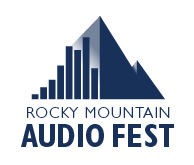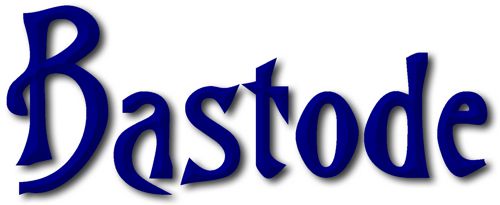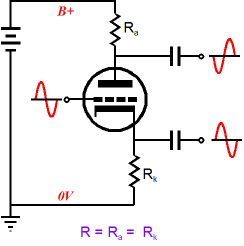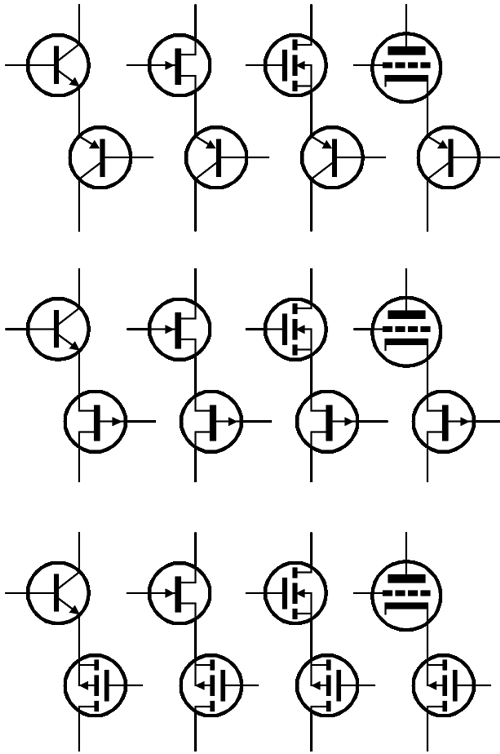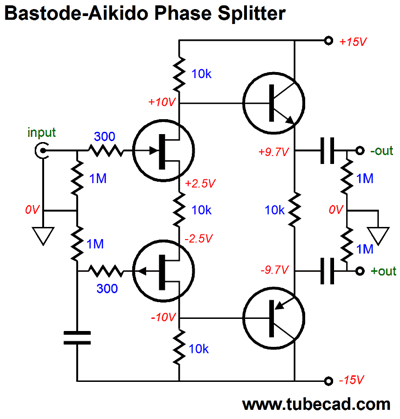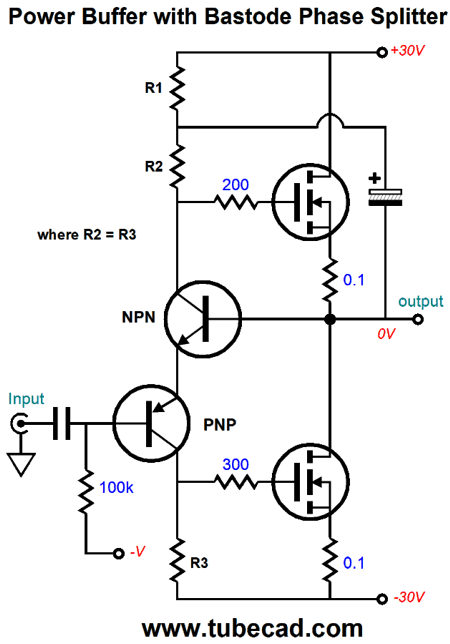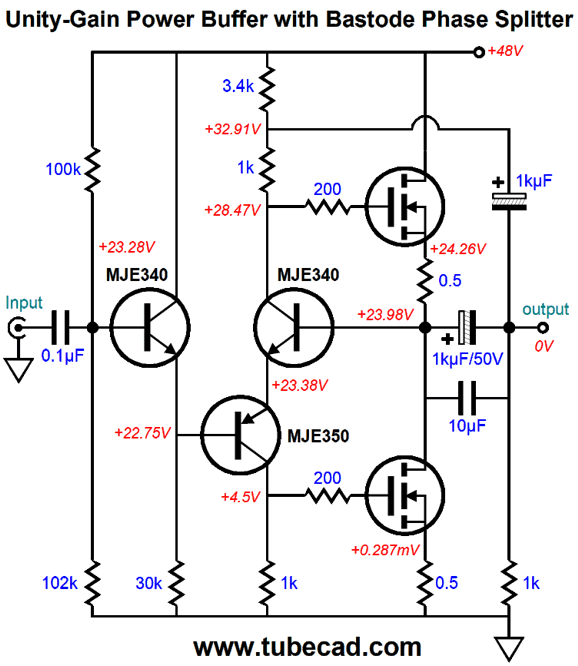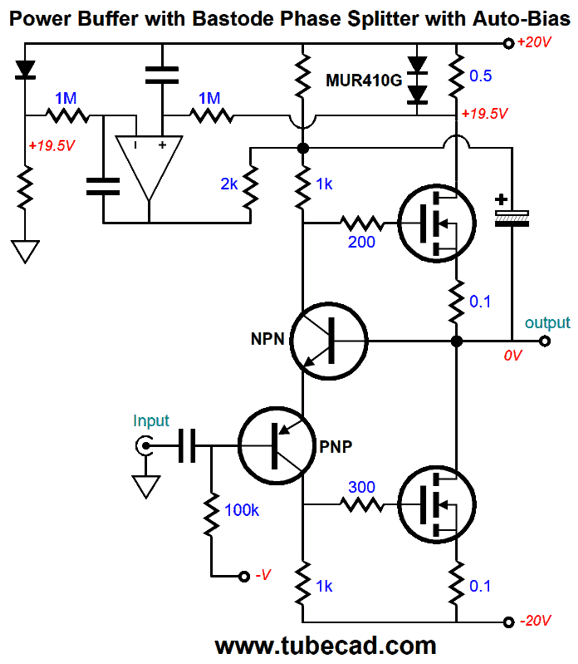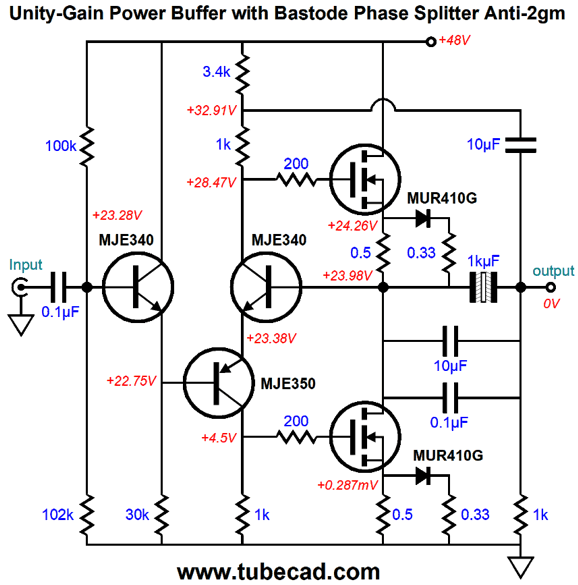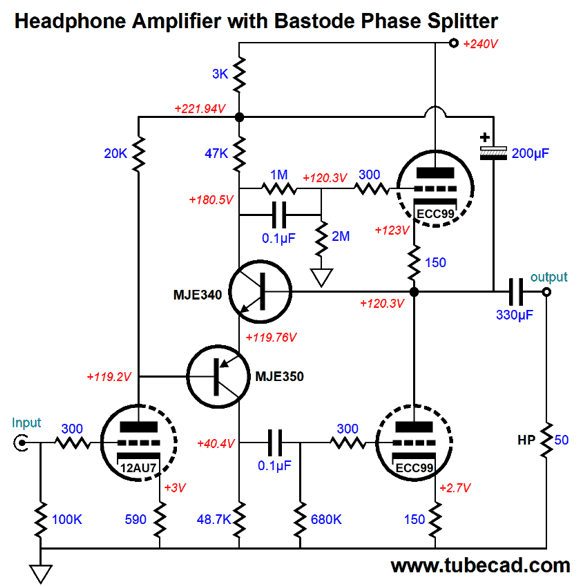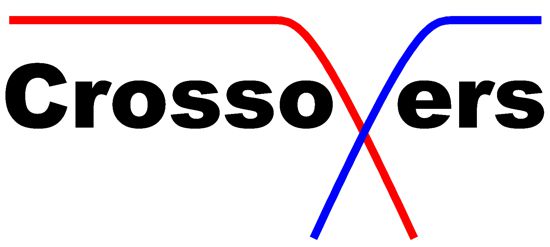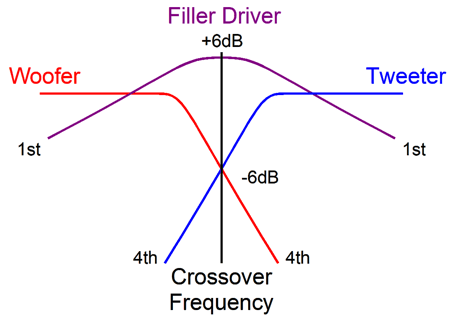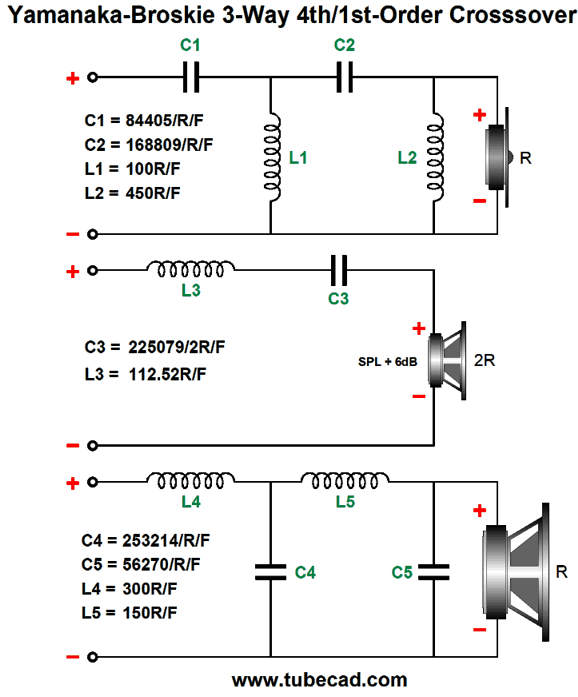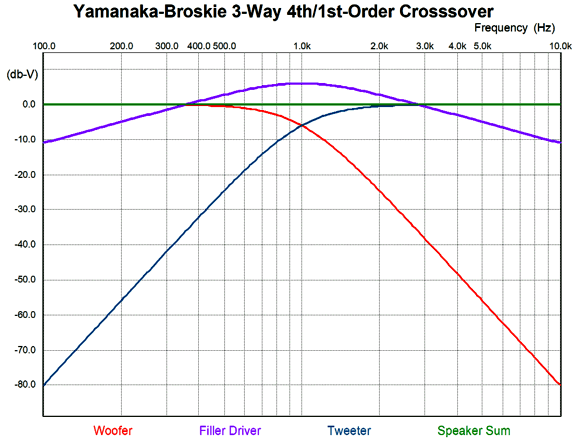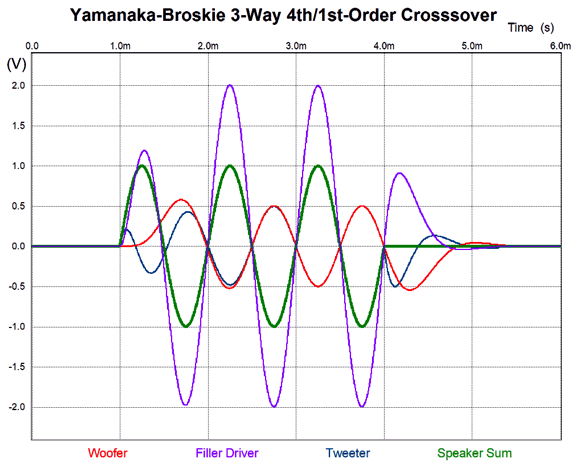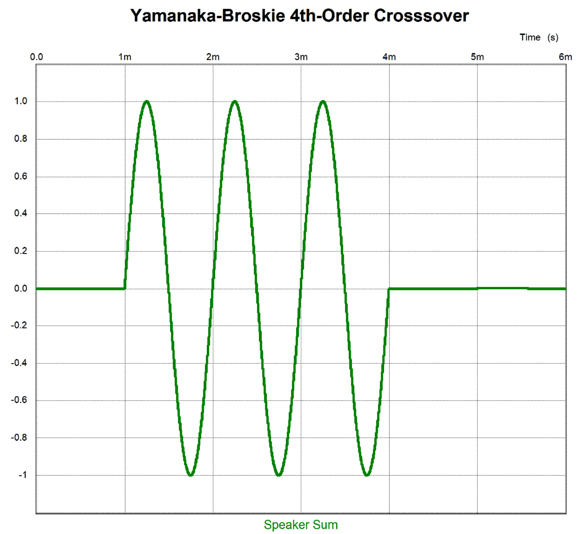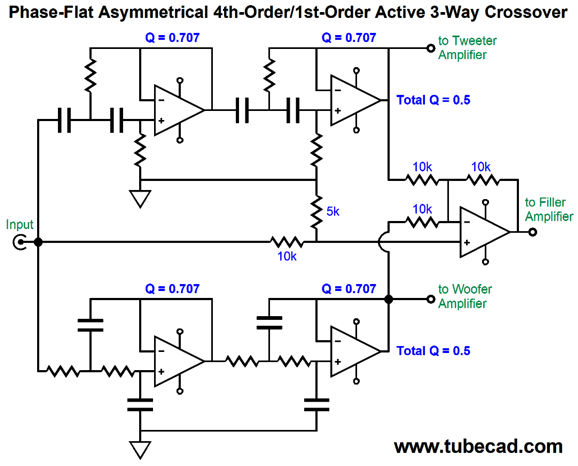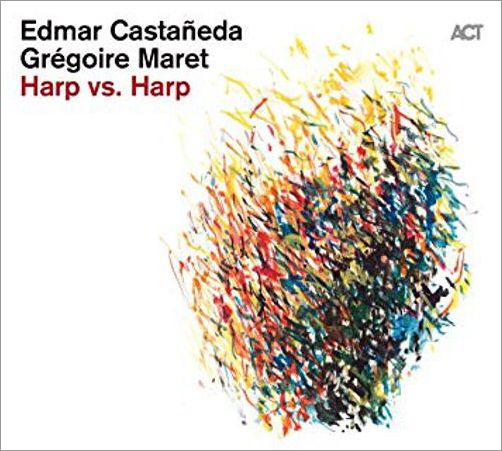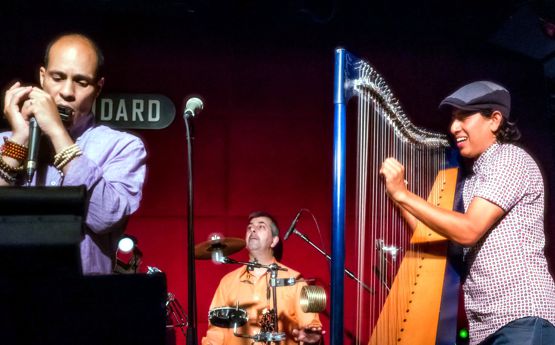| John Broskie's Guide to Tube Circuit Analysis & Design |
|
06 September 2019 Post 476
Rumors of RMAF
Bastode-Based Split-Load Phase Splitter
The bastode is a cascode circuit made out of N flavor and P flavor devices, such as a triode and a PNP transistor or MOSFET. Here is 12 possible arrangements.
Well, we can force the sixth bastode, into a split-load-phase-splitter circuit, as I did back in post 294.
This phase splitter offers the same gain as the triode-based split-load phase splitter, either unity or two, depending on your perspective. In contrast, what I am about to display is a different sort of phase splitter, whose major difference is that we take advantage of the bastode's potential of offering screaming gain and the possibility of employing negative feedback. For example, the following is a power buffer that uses the bastode transistors both to create two anti-phase signals and to compare the output to the input and make the needed adjustments to bring the output in line with the input. The collector resistors, R2 and R3, see the same variation in current flow, so the same signal amplitude develops across them, but in the opposite phase. The two output MOSFETs are both N-channel devices, so at the top MOSFET draws more current, the bottom MOSFET draws less, as the top sees its gate voltage rise, while the bottom sees its gate voltage fall. The 1K µF bootstrap capacitor ensures equal source-to-gate voltage swings between the two MOSFETs. Resistor, R1, sets the idle current flow through the MOSFETs, albeit in an indirect fashion. The larger the resistor value, the less current flow will be; the smaller the value, the higher the current flow. We can use a mono-polar power supply.
If we are willing to run the output MOSFET in strict class-A, we can use an auto-bias circuit to set the MOSFET idle current.
The OpAmp-based DC servo amplifier at that top monitors the current flow the 0.5-ohm drain resistor to the voltage drop across the diode (another MUR410G) voltage drop on the left. If the output stage draws too much current, the voltage drop across the current-sense resistor will increase, which will prompt the OpAmp's output to swing negatively, thereby bringing down bias voltage to both the output MOSFETs. On the other hand, we could go the anti-2gm route with a lower idle current.
The two MUR410G rectifiers only switch on when the opposing MOSFET cuts off, allowing the still engaged MOSFET's effectively transconductance to double, thereby ensuring constant-transconductance. If you are wondering where the tubes are, here they are. The ECC99 output triodes idle at a heavy 18.4mA and both get an unbypassed cathode resistor; yet, the output impedance is less than 1-ohm. How's that possible? The bastode stage offers a bunch of signal gain and all of it is returned as negative feedback, as the bastode's inverting input (the MJE340's base) connects directly to the output stage's output, resulting in a unity-gain output stage. The 12AU7 input tube realizes a gain roughly equal to its amplification factor (mu), which for a 12AU7 is between 17 to 18. The headphone amplifier's PSRR is also fine, coming in at better than -6dB in SPICE simulations. In addition, the current-swing balance between top and bottom triodes is excellent.
More Dang Crossovers
Here is what I found worked fairly well. The woofer and tweeter see 4th-order filters made from cascaded Butterworth filters with a Q of 0.707. Another name for this crossover type is the Linkwitz-Riley 4th-order or the LR4, as the final Q is equal to the 0.707² or 0.5, which results in the woofer and tweeter being down by -6dB at the crossover frequency. Alas, the LR4 crossover results in a doubling of the nominal speaker impedance at the crossover frequency. In other words, if 8-ohm drivers are used, the peak impedance equals 16 ohms. This explains why I specify a 2R impedance for the filler driver, as this will flatten the impedance back to R. Of course, it's hard to find good 16-ohm fullrange drivers, so the best procedure is to use a 4-ohm woofer and tweeter, so that an 8-ohm filler driver can be used. In addition, the filler driver must deliver an SPL that is 6dB higher than the woofer and tweeter's SPL and must offer wide bandwidth frequency response (think fullrange driver). Unlike a 2nd-order Linkwitz-Riley crossover, all the drivers must be wired in phase with each other. The frequency response is flat, as is the phase response. Here is a three-cycle tone burst. Note how cleanly the sum output starts and stops; also note how the filler driver puts out twice the signal that the woofer and tweeter do, yet the sum is equal to the woofer and tweeter output. It might be hard to see, but the speaker sum is a perfect 1kHz tone burst of three cycles. Here is just the sum:
In general, high-order passive crossover are a pain, as the part tolerances must be extra tight and the driver impedance should be as close to ruler flat as possible. In contrast active crossovers are much more easily implemented, as 1% capacitors and 0.1% resistors can easily be found. This crossover uses a differential amplifier to create the required slopes for the filer driver. The differential amplifier's 5k and 10k resistors should be 0.1% types to ensure good performance. The differential amplifier allows us two break with quasi-two-way aspect and go for a more conventional three-way crossover, without having to change the differential amplifier resistor values. For example, the tweeter might see a crossover frequency of 4kHz, while the woofer sees a 400Hz crossover frequency. Bear in mind that the filler driver must exhibit truly wide frequency response in this three-way setup.
Music Recommendation: Harp vs. Harp Needless to say, as you have no doubt figured out my MO by now, Harp vs. Harp is available at Tidal. Do give it a listen, as your speakers long to bounce to the jazzy Latin beats. //JRB
User Guides for GlassWare Software
For those of you who still have old computers running Windows XP (32-bit) or any other Windows 32-bit OS, I have setup the download availability of my old old standards: Tube CAD, SE Amp CAD, and Audio Gadgets. The downloads are at the GlassWare-Yahoo store and the price is only $9.95 for each program. http://glass-ware.stores.yahoo.net/adsoffromgla.html So many have asked that I had to do it. WARNING: THESE THREE PROGRAMS WILL NOT RUN UNDER VISTA 64-Bit or WINDOWS 7 & 8 or any other 64-bit OS. I do plan on remaking all of these programs into 64-bit versions, but it will be a huge ordeal, as programming requires vast chunks of noise-free time, something very rare with children running about. Ideally, I would love to come out with versions that run on iPads and Android-OS tablets.
//JRB
|
|
John Gives
Special Thanks to the Special 83
I am truly stunned and appreciative of their support. In addition I want to thank the following patrons:
All of your support makes a big difference. I would love to arrive at the point where creating my posts was my top priority of the day, not something that I have to steal time from other obligations to do. The more support I get, the higher up these posts move up in deserving attention. Only those who have produced a technical white paper or written an article on electronics know just how much time and effort is required to produce one of my posts, as novel circuits must be created, SPICE simulations must be run, schematics must be drawn, and thousands of words must be written. If you have been reading my posts, you know that my lifetime goal is reaching post 1,000. I have 524 more to go. My second goal is to gather 1,000 patrons. I have 917 patrons to go. Help me get there.
Only $12.95 TCJ My-Stock DB
Version 2 Improvements *User definable Download for www.glass-ware.com |
||
| www.tubecad.com Copyright © 1999-2019 GlassWare All Rights Reserved |
